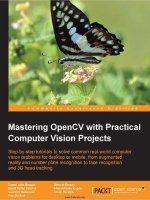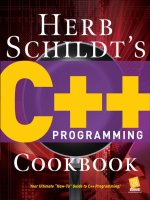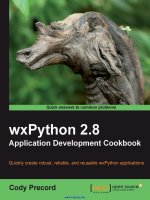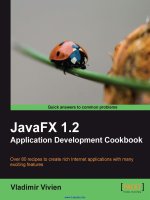opencv 2 computer vision application programming cookbook
Bạn đang xem bản rút gọn của tài liệu. Xem và tải ngay bản đầy đủ của tài liệu tại đây (6.68 MB, 304 trang )
www.it-ebooks.info
OpenCV 2 Computer Vision
Application Programming
Cookbook
Over 50 recipes to master this library of programming
functions for real-time computer vision
Robert Laganière
BIRMINGHAM - MUMBAI
www.it-ebooks.info
OpenCV 2 Computer Vision Application
Programming Cookbook
Copyright © 2011 Packt Publishing
All rights reserved. No part of this book may be reproduced, stored in a retrieval system, or
transmitted in any form or by any means, without the prior written permission of the publisher,
except in the case of brief quotations embedded in critical articles or reviews.
Every effort has been made in the preparation of this book to ensure the accuracy of the
information presented. However, the information contained in this book is sold without
warranty, either express or implied. Neither the author, nor Packt Publishing, and its dealers
and distributors will be held liable for any damages caused or alleged to be caused directly or
indirectly by this book.
Packt Publishing has endeavored to provide trademark information about all of the companies
and products mentioned in this book by the appropriate use of capitals. However, Packt
Publishing cannot guarantee the accuracy of this information.
First published: May 2011
Production Reference: 1180511
Published by Packt Publishing Ltd.
32 Lincoln Road
Olton
Birmingham, B27 6PA, UK.
ISBN 978-1-849513-24-1
www.packtpub.com
Cover Image by Asher Wishkerman ()
www.it-ebooks.info
Credits
Author
Robert Laganière
Reviewers
Wajihullah Biaq
Luis Gomez
Vladislav Gubarev
Haikel Guemar
Xiangjun Shi
Acquisition Editor
Usha Iyer
Development Editor
Roger D'souza
Technical Editor
Kavita Iyer
Copy Editor
Neha Shetty
Project Coordinator
Srimoyee Ghoshal
Proofreader
Joel Johnson
Indexer
Tejal Daruwale
Graphics
Nilesh Mohite
Production Coordinator
Kruthika Bangera
Cover Work
Kruthika Bangera
www.it-ebooks.info
About the Author
Robert Laganière is a professor at the University of Ottawa, Canada. He received his Ph.D.
degree from INRS-Telecommunications in Montreal in 1996. Dr. Laganière is a researcher in
computer vision with an interest in video analysis, intelligent visual surveillance, and image-
based modeling. He is a co-founding member of the VIVA research lab. He is also a Chief
Scientist at iWatchLife.com, a company offering a cloud-based solution for remote monitoring.
Dr. Laganière is the co-author of
Object-oriented Software Engineering published by McGraw
Hill in 2001.
Visit the author's website at
e.
I wish to thank all my students at the VIVA lab. I learn so much from them.
I am also grateful to my beloved Marie-Claude, Camille, and Emma for their
continuous support.
www.it-ebooks.info
About the Reviewers
Wajih Ullah Baig holds a Honors. Degree in Computer Science from Hamdard University,
Karachi. He works mostly with with desktop applications and has good experience working
with large-scale distributed systems. He has interest in DSP, image processing, pattern
recognition, and network programming. He has worked on a large-scale content-based video
retrieval project which is one of its kind. Currently, he is working with the Center for Advanced
Research in Engineering, Islamabad, Pakistan where he holds a position as a design engineer.
As a freelancer, he contributes work for open source projects and posts codes of his own.
I would like to thank all my friends and family for their support whilst
reviewing the book. Especially my roommate, Dara Baig!
Lluís Gómez i Bigordà holds a Masters degree in Computer Science from the Universitat
Oberta de Catalunya.
I would like to thank all my family and friends for their support while I was
reviewing this book, especially to Antonia, my daughter. I owe you one!
www.it-ebooks.info
Vladislav Gubarev was born in 1987 in Baku, USSR.
He graduated from Southern Federal University (Russia) with honors. He has a Bachelor
(2007) and a Specialist (2008) diplomas of applied mathematics and computer science.
He started his career as a researcher and engineer in "Laboratory of Mathematical Methods
of Articial Intelligence". He later became a co-founder of CVisionLab company which provides
computer vision solutions.
His areas of research interests are mostly related to image and video processing. In addition
to researcher skills, he has wide experience in software development.
Many thanks to my wife Agatha. She is an applied mathematician, software
developer, and the person who helped me a lot in reviewing this book. Also,
thanks to my colleagues—a team of great researchers and professional
developers.
Haïkel Guémar has been a free software enthusiast and a Fedora developer for a few years
now. He currently works as a senior software engineer in a startup in Lyon (France): SysFera.
Turning coffee into code, QA process, and technical coaching are part of his daily occupation.
SysFera's main product is SysFera-DS, the commercial version of the award-winning open
source grid computing middleware DIET. DIET is an innovative grid middleware that offers
seamless, robust, and high-performance access to heterogeneous computing resources.
Besides being a code monkey, Haïkel enjoys practicing kendo and watching chambara movies.
Xiangjun Shi received the M.E. degree in Computer Graphics from Zhengjian University,
China in 1989, M.S. degree in Statistics, and Ph.D. degree in Computer Science from Utah
State University in 2006. From 1989 to 1998, he was an Assistant Professor in Hangzhou
University (1989–1995) and Shantou University (1995–1998). From 1998 to 2000, he was
an Associate Professor in Shantou University. Since 2007, he has worked on the design and
development of Intelligent Video Surveillance System. His research interests include: Data
Mining, Data Cleansing, Statistical Inference/Analysis, Digital Video Mining, Computer Vision,
Pattern Recognition and Image Processing, Mathematical modeling, and Algorithm Design
and Optimization.
www.it-ebooks.info
www.PacktPub.com
Support les, eBooks, discount offers and more
You might want to visit www.PacktPub.com for support les and downloads related to your
book.
Did you know that Packt offers eBook versions of every book published, with PDF and ePub
les available? You can upgrade to the eBook version at www.PacktPub.com and as a print
book customer, you are entitled to a discount on the eBook copy. Get in touch with us at
for more details.
At www.PacktPub.com, you can also read a collection of free technical articles, sign up for
a range of free newsletters and receive exclusive discounts and offers on Packt books and
eBooks.
Do you need instant solutions to your IT questions? PacktLib is Packt's online digital book
library. Here, you can access, read and search across Packt's entire library of books.
Why Subscribe?
f Fully searchable across every book published by Packt
f Copy and paste, print and bookmark content
f On demand and accessible via web browser
Free Access for Packt account holders
If you have an account with Packt at www.PacktPub.com, you can use this to access
PacktLib today and view nine entirely free books. Simply use your login credentials for
immediate access.
www.it-ebooks.info
www.it-ebooks.info
Table of Contents
Preface 1
Chapter 1: Playing with Images 7
Introduction 7
Installing the OpenCV library 8
Creating an OpenCV project with MS Visual C++ 11
Creating an OpenCV project with Qt 19
Loading, displaying, and saving images 26
Creating a GUI application using Qt 30
Chapter 2: Manipulating the Pixels 37
Introduction 37
Accessing pixel values 38
Scanning an image with pointers 41
Scanning an image with iterators 49
Writing efcient image scanning loops 51
Scanning an image with neighbor access 55
Performing simple image arithmetic 59
Dening regions of interest 63
Chapter 3: Processing Images with Classes 69
Introduction 69
Using the Strategy pattern in algorithm design 70
Using a Controller to communicate with processing modules 76
Using the Singleton design pattern 80
Using the Model-View-Controller architecture to design an application 82
Converting color spaces 85
Chapter 4: Counting the Pixels with Histograms 89
Introduction 89
Computing the image histogram 89
www.it-ebooks.info
ii
Table of Contents
Applying look-up tables to modify image appearance 96
Equalizing the image histogram 101
Backprojecting a histogram to detect specic image content 103
Using the mean shift algorithm to nd an object 108
Retrieving similar images using histogram comparison 112
Chapter 5: Transforming Images with Morphological Operations 117
Introduction 117
Eroding and dilating images using morphological lters 118
Opening and closing images using morphological lters 122
Detecting edges and corners using morphological lters 125
Segmenting images using watersheds 131
Extracting foreground objects with the GrabCut algorithm 137
Chapter 6: Filtering the Images 141
Introduction 141
Filtering images using low-pass lters 142
Filtering images using a median lter 147
Applying directional lters to detect edges 148
Computing the Laplacian of an image 156
Chapter 7: Extracting Lines, Contours, and Components 163
Introduction 163
Detecting image contours with the Canny operator 164
Detecting lines in images with the Hough transform 167
Fitting a line to a set of points 178
Extracting the components' contours 182
Computing components' shape descriptors 186
Chapter 8: Detecting and Matching Interest Points 191
Introduction 191
Detecting Harris corners 192
Detecting FAST features 203
Detecting the scale-invariant SURF features 206
Describing SURF features 212
Chapter 9: Estimating Projective Relations in Images 217
Introduction 217
Calibrating a camera 219
Computing the fundamental matrix of an image pair 228
Matching images using random sample consensus 233
Computing a homography between two images 242
www.it-ebooks.info
iii
Table of Contents
Chapter 10: Processing Video Sequences 247
Introduction 247
Reading video sequences 248
Processing the video frames 251
Writing video sequences 261
Tracking feature points in video 266
Extracting the foreground objects in video 272
Index 279
www.it-ebooks.info
www.it-ebooks.info
Preface
In today's digital world, images and videos are everywhere, and with the advent of powerful
and affordable computing devices, it has never been easier to create sophisticated imaging
applications. Plentiful software tools and libraries manipulating images and videos are
offered, but for anyone who wishes to develop his/her own applications, the OpenCV library is
the tool to use.
OpenCV (Open Source Computer Vision) is an open source library containing more than 500
optimized algorithms for image and video analysis. Since its introduction in 1999, it has
been largely adopted as the primary development tool by the community of researchers and
developers in computer vision. OpenCV was originally developed at Intel by a team led by
Gary Bradski as an initiative to advance research in vision and promote the development of
rich, vision-based CPU-intensive applications. After a series of beta releases, version 1.0 was
launched in 2006. A second major release occurred in 2009 with the launch of OpenCV 2 that
proposed important changes, especially the new C++ interface which we use in this book. At
the time of writing, the latest release is 2.2 (December 2010).
This book covers many of the library's features and shows how to use them to accomplish
specic tasks. Our objective is not to provide a complete and detailed coverage of every
option offered by the OpenCV functions and classes, but rather to give you the elements you
need to build your applications from the ground up. In this book we also explore fundamental
concepts in image analysis and describe some of the important algorithms in computer vision.
This book is an opportunity for you to get introduced to the world of image and video analysis.
But this is just the beginning. The good news is that OpenCV continues to evolve and expand.
Just consult the OpenCV online documentation to stay updated about what the library can do
for you:
/>www.it-ebooks.info
Preface
2
What this book covers
Chapter 1, Playing with Images, introduces the OpenCV library and shows you how to run
simple applications using the MS Visual C++ and Qt development environments.
Chapter 2, Manipulating the Pixels, explains how an image can be read. It describes different
methods for scanning an image in order to perform an operation on each of its pixels. You will
also learn how to dene region of interest inside an image.
Chapter 3, Processing Images with Classes, consists of recipes which present various object-
oriented design patterns that can help you to build better computer vision applications.
Chapter 4, Counting the Pixels with Histograms, shows you how to compute image histograms
and how they can be used to modify an image. Different applications based on histograms are
presented that achieve image segmentation, object detection, and image retrieval.
Chapter 5, Transforming Images with Morphological Operations, explores the concept of
mathematical morphology. It presents different operators and how they can be used to detect
edges, corners, and segments in images.
Chapter 6, Filtering the Images, teaches you the principle of frequency analysis and image
ltering. It shows how low-pass and high-pass lters can be applied to images. It presents the
two image derivative operators: the gradient and the Laplacian.
Chapter 7, Extracting Lines, Contours, and Components, focuses on the detection of
geometric image features. It explains how to extract contours, lines, and connected
components in an image.
Chapter 8, Detecting and Matching Interest Points, describes various feature point detectors
in images. It also explains how descriptors of interest points can be computed and used to
match points between images.
Chapter 9, Estimating Projective Relations in Images, analyzes the different relations involved
in image formation. It also explores the projective relations that exist between two images of a
same scene.
Chapter 10, Processing Video Sequences, provides a framework to read and write a video
sequence and to process its frames. It also shows you how it is possible to track feature
points from frame to frame, and how to extract the foreground objects moving in front of a
camera.
www.it-ebooks.info
Preface
3
Who this book is for
If you are a novice C++ programer who wants to learn how to use the OpenCV library to build
computer vision applications, then this cookbook is appropriate for you. It is also suitable
for professional software developers wishing to be introduced to the concepts of computer
vision programming. It can be used as a companion book in university-level computer vision
courses. It constitutes an excellent reference for graduate students and researchers in image
processing and computer vision. The book provides a good combination of basic to advanced
recipes. Basic knowledge of C++ is required.
Conventions
In this book, you will nd a number of styles of text that distinguish between different kinds of
information. Here are some examples of these styles, and an explanation of their meaning.
Code words in text are shown as follows: "We can include other contexts through the use of
the include directive."
A block of code is set as follows:
// get the iterators
cv::Mat_<cv::Vec3b>::const_iterator it=
image.begin<cv::Vec3b>();
When we wish to draw your attention to a particular part of a code block, the relevant lines or
items are set in bold:
// Converting to Lab color space
cv::cvtColor(image, converted, CV_BGR2Lab);
// get the iterators of the converted image
cv::Mat_<cv::Vec3b>::iterator it=
New terms and important words are shown in bold. Words that you see on the screen, in
menus or dialog boxes for example, appear in the text like this: "This value is read when the
Process button is clicked, which also triggers the processing and displays the result".
Tips and tricks appear like this.
www.it-ebooks.info
Preface
4
Reader feedback
Feedback from our readers is always welcome. Let us know what you think about this book—
what you liked or may have disliked. Reader feedback is important for us to develop titles that
you really get the most out of.
To send us general feedback, simply send an e-mail to , and
mention the book title via the subject of your message.
If there is a book that you need and would like to see us publish, please send us a note in the
SUGGEST A TITLE form on www.packtpub.com or e-mail
If there is a topic that you have expertise in and you are interested in either writing or
contributing to a book, see our author guide on www.packtpub.com/authors.
Customer support
Now that you are the proud owner of a Packt book, we have a number of things to help you to
get the most from your purchase.
Downloading the example code
You can download the example code les for all Packt books you have purchased from your
account at . If you purchased this book elsewhere, you can visit
and register to have the les e-mailed directly to you.
Errata
Although we have taken every care to ensure the accuracy of our content, mistakes do happen.
If you nd a mistake in one of our books—maybe a mistake in the text or the code—we would be
grateful if you would report this to us. By doing so, you can save other readers from frustration
and help us improve subsequent versions of this book. If you nd any errata, please report them
by visiting selecting your book, clicking on the errata
submission form link, and entering the details of your errata. Once your errata are veried, your
submission will be accepted and the errata will be uploaded on our website, or added to any
list of existing errata, under the Errata section of that title. Any existing errata can be viewed by
selecting your title from />Piracy
Piracy of copyright material on the Internet is an ongoing problem across all media. At Packt,
we take the protection of our copyright and licenses very seriously. If you come across any
illegal copies of our works, in any form, on the Internet, please provide us with the location
address or website name immediately so that we can pursue a remedy.
Please contact us at with a link to the suspected pirated
material.
www.it-ebooks.info
Preface
5
We appreciate your help in protecting our authors, and our ability to bring you valuable content.
Questions
You can contact us at if you are having a problem with any
aspect of the book, and we will do our best to address it.
www.it-ebooks.info
www.it-ebooks.info
1
Playing with Images
In this chapter, we will cover:
f Installing the OpenCV Library
f Creating an OpenCV project with MS Visual C++
f Creating an OpenCV project with Qt
f Loading, displaying, and saving images
f Creating a GUI application using Qt
Introduction
This chapter will teach you the basic elements of OpenCV and will show you how to
accomplish the most fundamental tasks: reading, displaying, and saving images. Before you
can start with OpenCV, you need to install the library. This is a simple process that is explained
in the rst recipe of this chapter.
You also need a good development environment (IDE) to run your OpenCV applications. We
propose two alternatives here. The rst is to use the well-known Microsoft Visual Studio
platform. The second option is to use an open source tool for C++ project development
called Qt. Two recipes will show you how to set up a project with these two tools, but you can
also use other C++ IDEs. In fact, in this cookbook, the tasks will be presented in a way that
is independent of any particular environment and operating system, so you are free to use
the one of your choice. However, be aware that you need to use the compiled version of the
OpenCV library that is appropriate to the compiler and operating system you are using. If you
obtain strange behaviors, or if your application crashes without apparent reasons, that could
be a symptom of incompatibilities.
www.it-ebooks.info
Playing with Images
8
Installing the OpenCV library
OpenCV is an open source library for developing computer vision applications. It can be
used in both academic and commercial applications under a BSD license that allows you to
freely use, distribute, and adapt it. This recipe will show you how to install the library on your
machine.
Getting ready
When you visit the OpenCV ofcial website at />wiki/
, you will nd the latest release of the library, the online documentation, and many
other useful resources about OpenCV.
How to do it
From the OpenCV website, go to the Download page that corresponds to the platform of your
choice (Linux/Unix/Mac or Windows). From there you will be able to download the OpenCV
package. You will then uncompress it, normally under a directory with a name corresponding
to the library version (for example, OpenCV2.2). Once this is done, you will nd a collection
of directories, notably the doc directory containing the OpenCV documentation, the include
directory containing all of the include les, the modules directory which contains all of
the source les (yes, it is open source), and the samples directory containing many small
examples to help you to get started.
If you are working under Windows with Visual Studio, you also have the option to download the
executable installation package corresponding to your IDE and Windows platform. Executing
this setup program will not only install the source library, but also all of the precompiled
binaries you will need to build your applications. In that case, you are ready to start using
OpenCV. If not, you need to take few additional steps.
In order to use OpenCV under the environment of your choice, you need to generate the library
binary les using the appropriate C++ compiler. To build OpenCV, you need to use the CMake
tool available at CMake is another open source software tool
designed to control the compilation process of a software system using platform-independent
conguration les. You therefore need to download and install CMake. You can then run it
using the command line, but it is easier to use CMake with its Graphical User Interface (GUI).
In this latter case, all you need to do is to specify the folder containing the OpenCV library
and the one that will contain the binaries. You then click on Congure in order to select the
compiler of your choice (here we chose Visual Studio 2010), and you click on Congure again,
as seen in the following screenshot:
www.it-ebooks.info
Chapter 1
9
You are now ready to generate your makefiles and workspace les by clicking on the
Generate button. These les will allow you to compile the library. This is the last step of the
installation process.
Compiling the library will make it ready to use for your development environment. If you
selected an IDE like Visual Studio, then all you need to do is to open the top-level solution
le that CMake has created for you. You then issue the Build Solution command. In Unix
environments, you will use the generated makefiles by running your make utility
command.
If everything went well, you should now have your compiled and ready-to-use OpenCV library
in the specied directory. This directory will contain, in addition to the directories we already
mentioned, a bin directory containing the compiled library. You can move everything to your
preferred location (for example, c:\OpenCV2.2) and add the bin directory to your system
path (under Windows, this is done by opening your Control Panel. You start the System utility
and under the Advanced tab, you will nd the Environment Variables button).
www.it-ebooks.info
Playing with Images
10
How it works
Since version 2.2, the OpenCV library is divided into several modules. These modules are built
in library les located in the lib directory. They are:
f The opencv_core module that contains the core functionalities of the library, in
particular, the basic data structures and arithmetic functions.
f The opencv_imgproc module that contains the main image processing functions.
f The opencv_highgui module that contains the image and video reading and
writing functions, along with other user interface functions.
f The opencv_features2d module that contains the feature point detectors and
descriptors and the feature point matching framework.
f The opencv_calib3d module that contains the camera calibration, two-view
geometry estimation, and stereo functions.
f The opencv_video module that contains the motion estimation, feature tracking,
and foreground extraction functions and classes.
f The opencv_objdetect module containing the object detection functions such as
the face and people detectors.
The library also includes other utility modules containing machine learning functions (
opencv_
ml
), computational geometry algorithms (opencv_flann), contributed code (opencv_
contrib), obsolete code (opencv_legacy), and GPU accelerated code (opencv_gpu).
All of these modules have a header le associated with them (located in
include directory).
Typical OpenCV C++ code will therefore start by including the required modules. For example
(and this is the suggested declaration style):
#include <opencv2/core/core.hpp>
#include <opencv2/imgproc/imgproc.hpp>
#include <opencv2/highgui/highgui.hpp>
If you see OpenCV code starting with:
#include "cv.h"
it is because it uses the old style, before the library was restructured into modules.
There's more
You can also access the latest code being developed from the OpenCV SVN server located at:
/>You will nd that there are a large number of examples that can help you learn how to use the
library and give you many development tips.
www.it-ebooks.info
Chapter 1
11
Creating an OpenCV project with MS Visual
C++
Using MS Visual C++, you can easily create OpenCV applications for Windows. You can build
simple console application or you can create more sophisticated applications with a nice
graphical user interface (GUI). Since it is the easiest option, we will create a simple console
application here. We'll use Visual Studio 2010, however, the same principles also apply to
any other versions of the Microsoft IDE since the menus and options are very similar in the
different versions.
When you run Visual Studio for the rst time, you can set it up in a way such that C++
becomes your default development environment. This way, when you will launch the IDE, it will
be in Visual C++ mode.
We assume that you have installed OpenCV under the C:\OpenCV2.2 directory as explained
in the previous recipe.
Getting ready
When working with Visual Studio, it is important to understand the difference between a solution
and a project. Basically, a solution is made of several projects (each project is a distinct software
module, for example, a program and a library). This way the projects of your solution can share
les and libraries. Usually, you create one master directory for your solution that contains all
of your projects directories. But you can also group the solution and a project into one single
directory. This is what you will most often do for a one-project solution. As you become more
familiar with VC++, and build more complex applications, you should take advantage of the
multi-project solution structure.
Also, when you compile and execute your Visual C++ projects, you can do it under two different
congurations: Debug and Release. The Debug mode is there to help you create and debug your
application. It is a more protected environment, for example, it will tell you if your application
contains memory leaks or it will check at runtime if you are using certain functions properly.
However, it generates slower executable les. This is why, once your application has been tested
and is ready to be used, you build it under the Release mode. This will produce the executable
that you will distribute to the users of your application. Note that it may happen that you have
code running perfectly well in debug mode but has problems in release mode. You then need to
do more testing in order to identify the potential sources of errors. Debug and Release modes
are not unique to Visual C++, most IDEs also support these two modes of compilation.
www.it-ebooks.info
Playing with Images
12
How to do it
We are now ready to create our rst project. This is done by using the File|New Project
| Project… menu option. You can create different project types here. Let's start with the
simplest option which is to select a Win32 Console Application, seen in the following
screenshot:
You need to specify where your want to create your project, and what name you want to give to
your project. There is also an option for creating or not creating a directory for the solution (the
bottom-right checkbox). If you check this option, an additional directory will be created (with
the name you specify) that will contain your solution directory. If you simply leave this option
unchecked, a solution le (extension .sln) will still be created, but this one will be contained
within the same (single) project directory. Click on OK and then Next to go to the Application
Settings window of the Win32 Application Wizard. As seen in the following screenshot, a
number of options are offered there. We will simply create an empty project.
www.it-ebooks.info









